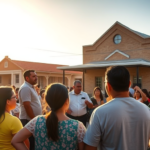Traffic Alert: Detour Around SH 4 for Overweight Trucks to Start Next Week
Starting Monday, October 14, Brownsville’s State Highway 4 (SH 4) will see a significant change affecting local traffic as overweight trucks—those exceeding 80,000 pounds—will be rerouted around ongoing construction. This detour, a strategic measure aimed at enhancing safety during the extensive development project, underscores the evolving infrastructure landscape in South Texas. The temporary route is necessary to facilitate pavement and sewer upgrades, promising benefits for Valley residents and local commerce upon completion.
Background on SH 4 Construction
The construction initiative on SH 4 is part of Texas Department of Transportation’s (TxDOT) larger roadmap for modernizing the Rio Grande Valley’s transportation network. Currently, this segment of the highway is reduced to one lane in each direction to accommodate the project, which involves replacing asphalt pavement with more durable concrete and upgrading the storm sewer system. Expected to conclude by March 2026, the project aligns with objectives to enhance safe and efficient transport routes vital for sustaining local economic growth.
Ray Pedraza, TxDOT Pharr District Public Information Officer, emphasized, “This undertaking is crucial for improving the long-term durability and safety of our transportation routes, which are vital for all South Texas residents.” TxDOT’s plan includes guided detours via FM 511 for affected vehicles, ensuring that disruptions to local traffic flow are minimized during construction. Law enforcement will actively monitor compliance to these detours.
Local Impact and Community Interest
This re-routing is more than a mere traffic advisory for the region—it represents a proactive step towards sustaining the traffic-dependent economy of the Rio Grande Valley (RGV). Brownsville, strategically positioned near the U.S.-Mexico border, serves as a pivotal hub for commerce and trade. The temporary detour is crucial for safeguarding both construction crews and drivers, underscoring the community-strategic importance of maintaining robust infrastructure.
“The detour is a minor inconvenience in the greater scheme,” commented Theresa Garza, a logistics manager at a local trucking firm. “Once completed, these improvements stand to substantially benefit freight operations, reducing long-term transportation costs and delays.”
Brownsville’s SH 4 project complements broader infrastructure goals across Cameron, Hidalgo, and Willacy counties, promising ripple effects that bolster economic vibrancy across various RGV communities like McAllen and Harlingen.
Connecting to Broader Issues
The public response to infrastructure changes echoes ongoing regional discussions about transportation and economic resilience in South Texas. Valley residents increasingly look to local authorities to prioritize projects that enhance connectivity, safety, and economic fluidity. In recent years, infrastructure projects have emphasized resilience against extreme weather conditions prevalent in this border region.
Moreover, parallel community transformations have been seen, such as McAllen’s recent infrastructural upgrades, which highlighted the synergy between infrastructure investments and urban development policies aimed at supporting the Valley’s prosperity. Insights from Texas Border Business have previously championed similar progress, noting infrastructures’ crucial role in bolstering trade and commerce networks.
Future Implications for Rio Grande Valley
The SH 4 detour, while temporary, sets a precedent for future infrastructure projects aimed at sustaining economic and social dynamics within the RGV. Keeping traffic disruption minimal during such upgrades promises smoother transitions for future projects, inviting investment and fostering commercial confidence in regional operations.
Experts suggest that as these improvements come to fruition, they’re likely to attract new businesses, not only in logistics but across sectors keenly reliant on consistent and reliable transport infrastructure. Particularly, this can spur new opportunities in nearby communities within the Valley and extend benefits to industries like agriculture, retail, and cross-border trade.
Reactions from the Community
Community members have expressed mixed feelings about the changes. While many endorse the long-term benefits, others voice concerns about immediate adjustments needed for rerouted journeys—especially for those whose routes consist of multiple transits through affected areas.
“The community’s cooperation and patience during these times play pivotal roles in achieving successful project completion and future traffic advancements,” stated James Cortez, a civil engineer involved with the project. He noted the consistent feedback community forums have received, a vital element in adapting communication and construction strategies to local needs.
Resources for Valley Residents
For updated traffic-related information and guidance through the construction phase, TxDOT directs queries to their digital platforms or the office of Ray Pedraza. Community members are encouraged to reach out via email at raymond.pedraza@txdot.gov or phone at (956) 279-5486 for clarifications. Regular updates will also be shared through Texas Border Business’s social media channels, ensuring Valley residents remain informed about RGV news developments and their local impact.
In conclusion, the SH 4 detour is a necessary conduit in the Valley’s infrastructure and economic renewal journey. Carefully calibrated to ensure minimal disruption, it harbors the promise of enhanced pathways for commerce, safety, and connectivity in the heart of South Texas. As the project unfolds, its meticulous orchestration reflects both the challenges and the transformative potential of infrastructure development in rapidly evolving communities like Brownsville and across the Rio Grande Valley.







